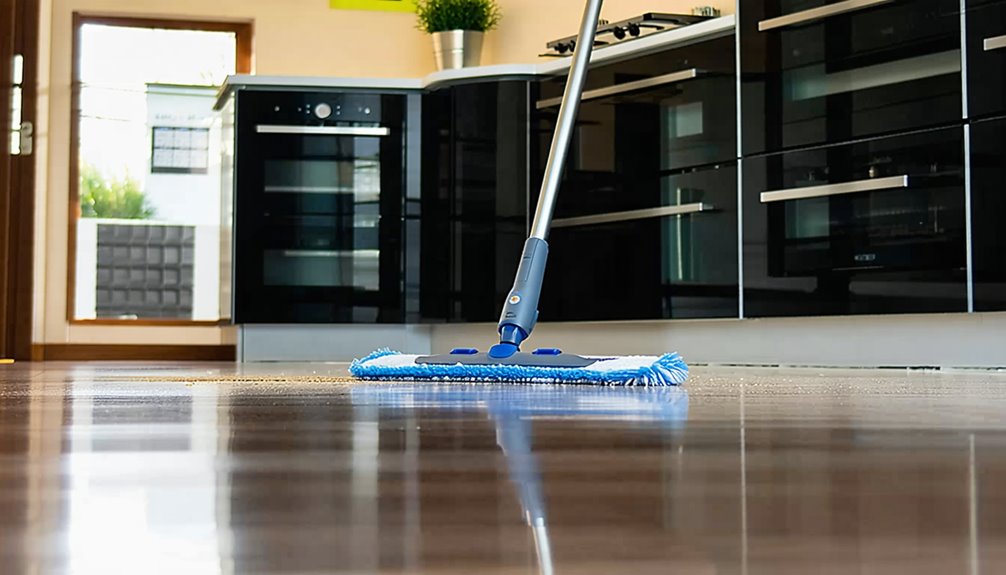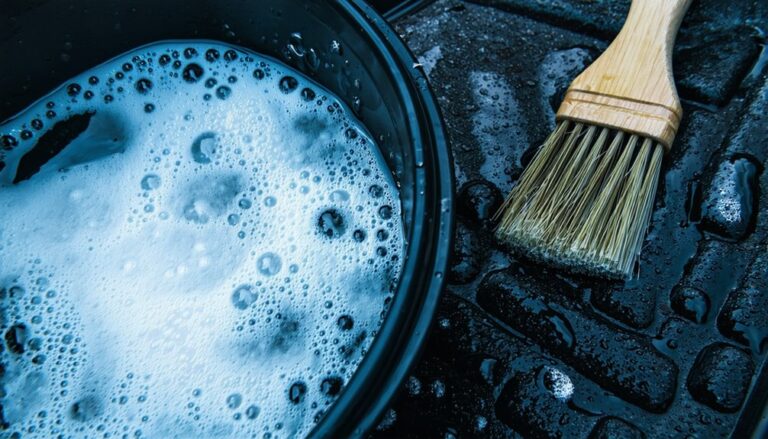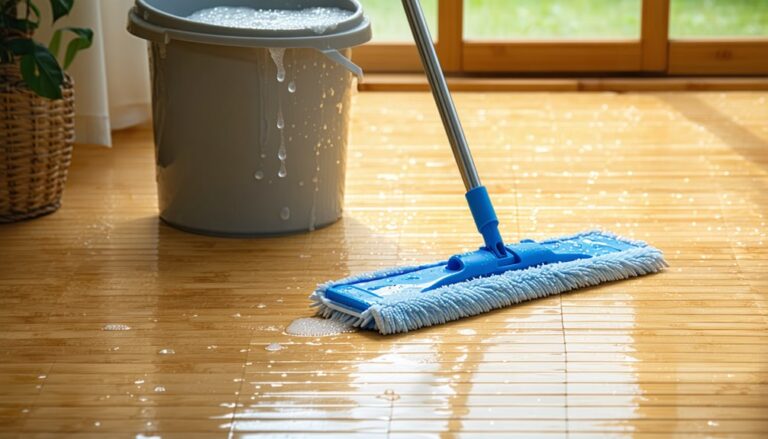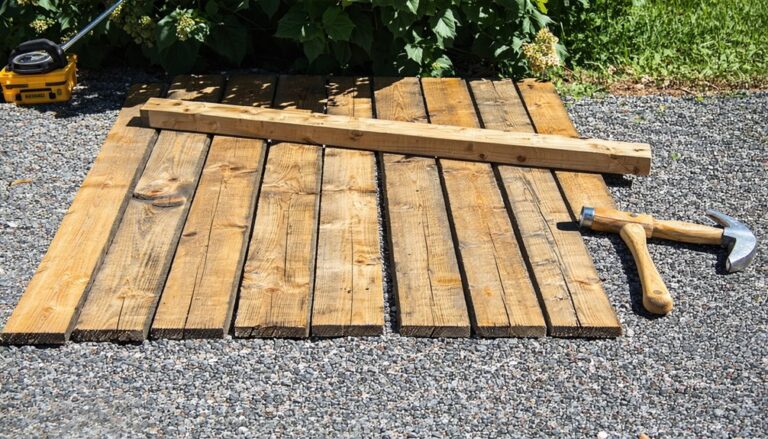You should mop your floors based on foot traffic and specific circumstances. For high-traffic areas, daily mopping is vital to prevent dirt buildup. If you have pets or children, you might need to mop more frequently. Generally, aim for weekly mopping to maintain cleanliness. For hardwood, less frequent mopping every 1-2 weeks is best, while tile can handle more regular cleaning. Monthly mopping allows for deeper maintenance, and spot cleaning is important for immediate messes. Tailoring your routine guarantees a clean and inviting home, and there's much more to think about to optimize your cleaning efforts.
Factors Influencing Mopping Frequency
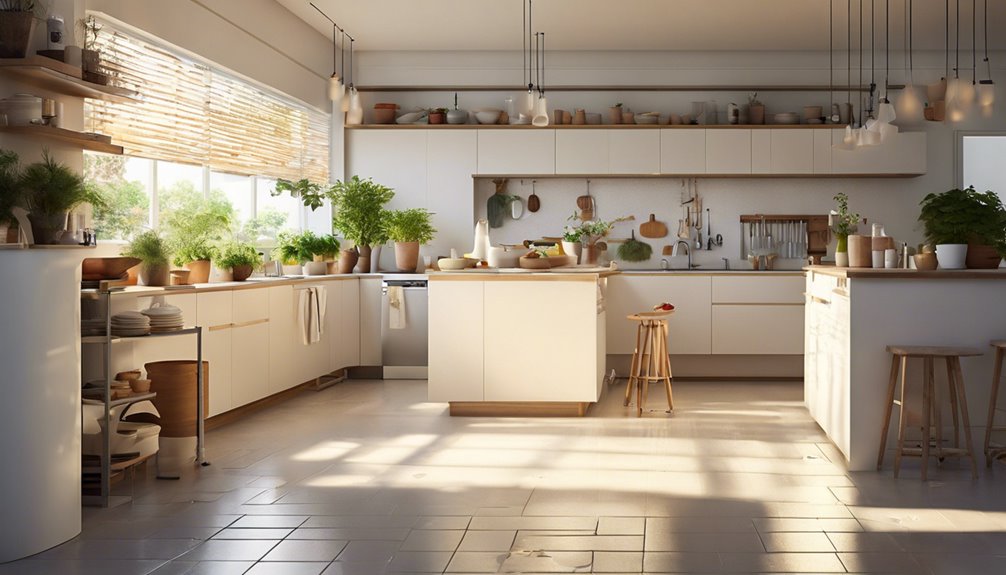
When considering how often to mop your floors, several factors come into play that can greatly influence your cleaning schedule. First, think about the foot traffic in your home. High-traffic areas, like hallways and kitchens, may require more frequent mopping to keep dirt and grime at bay. Also, consider the presence of pets or children; their activities can lead to spills and messes that necessitate a quicker response. Seasonal changes can also affect mopping frequency; during rainy months, for instance, you might find yourself mopping more often. Finally, your personal preferences and lifestyle choices will shape your cleaning schedule. By evaluating these factors, you can create a mopping frequency that aligns with your needs while maintaining a clean, welcoming environment.
Types of Flooring Considerations
When determining how often to mop your floors, it's essential to evaluate the type of flooring you have. Hard surface flooring, carpeted areas, and specialty flooring types each require different cleaning approaches and frequencies. Understanding these distinctions will help you maintain your floors effectively and prolong their lifespan.
Hard Surface Flooring
Many homeowners often overlook the specific needs of their hard surface flooring, which can vary widely depending on the type. For instance, hardwood requires gentle cleaning, ideally mopped every one to two weeks, while tile can handle more frequent cleaning due to its durability. Laminate flooring, on the other hand, benefits from a dry mop or a damp cloth to avoid excess moisture. Understanding the nuances of hard surface maintenance is essential for maintaining the beauty and longevity of your floors. Consider the cleaning frequency based on foot traffic, pets, and spills. Tailoring your approach to each flooring type allows you to preserve their unique characteristics while ensuring a clean and inviting environment for your home.
Carpeted Areas
Carpeted areas require a different approach to cleaning compared to hard surfaces, as their fibers can trap dirt, allergens, and moisture. For effective carpet maintenance, vacuum regularly—ideally once a week or more in high-traffic zones. This helps remove surface debris and prevents deeper soil buildup.
You should also consider occasional deep carpet cleaning, using professional services or renting a steam cleaner. Aim for this every 6 to 12 months, depending on usage and foot traffic. Don't forget to address spills promptly, as they can lead to stains if left untreated. By staying on top of these tasks, you'll maintain a fresh, inviting environment while prolonging the life of your carpet. Embrace this routine for a healthier home!
Specialty Flooring Types
While mopping is essential for maintaining clean floors, different specialty flooring types require tailored care to preserve their unique characteristics and longevity. For luxury vinyl, you'll want to use a damp mop with a gentle cleaner specifically designed for vinyl surfaces, as harsh chemicals can damage the finish. Aim to mop these floors every couple of weeks, or more often in high-traffic areas. Bamboo flooring, on the other hand, is more sensitive to moisture. It's best to use a barely damp mop and avoid soaking the surface. Mopping every month should suffice, but always guarantee you're not leaving excess water behind. By adjusting your cleaning routine, you can enjoy both beauty and durability in your specialty flooring.
Daily Mopping Guidelines
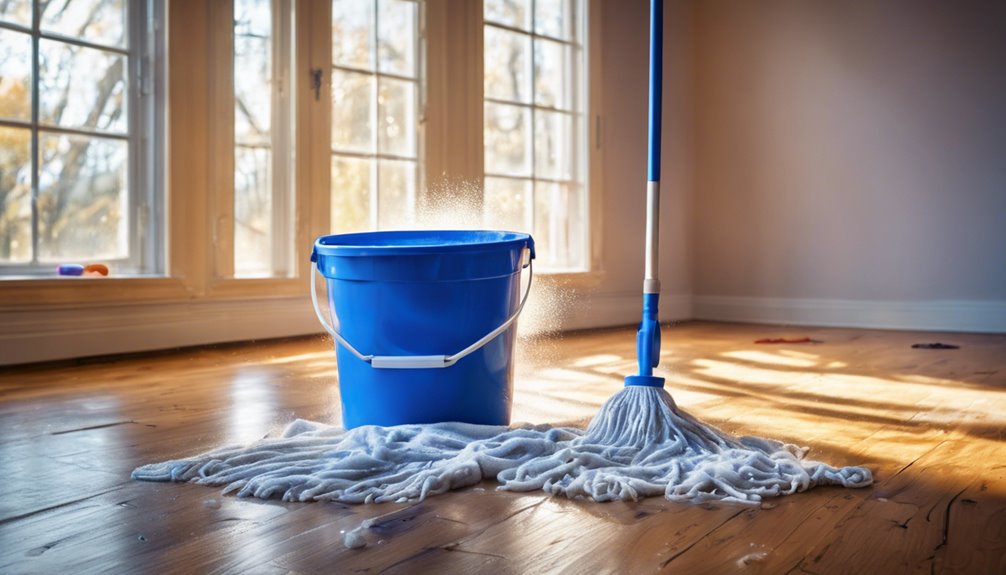
When it comes to daily mopping, you'll want to pay special attention to high-traffic areas, as they tend to accumulate dirt and grime more quickly. If spills or stains occur, addressing them promptly can prevent them from becoming more difficult to clean later on. Additionally, consider seasonal factors, like mud in the spring or salt in the winter, which may require more frequent mopping to maintain a clean pavimento.
#
High-Traffic Areas
Since high-traffic areas are prone to accumulating dirt and grime more quickly than other parts of your home, it's essential to adopt a daily mopping routine for these spaces. Regular cleaning not only enhances the appearance of your floors but also contributes to a healthier environment. The cleaning frequency in high traffic zones should ideally involve mopping at least once a day, especially in entryways, kitchens, and living rooms.
- Use a microfiber mop for efficient dirt pickup.
- Opt for a gentle, pH-balanced cleaner to protect your flooring.
- Always follow up with a thorough rinse to avoid residue buildup.
Spills and Stains
Even in high-traffic areas, unexpected spills and stains can occur, demanding immediate attention to maintain your floors' appearance and hygiene. Effective spill management is essential; the sooner you act, the better chance you have at preventing lasting damage. First, blot the spill with a clean cloth to absorb as much liquid as possible. For tougher stains, employ appropriate stain removal techniques, like using a suitable cleaner for your floor type. Always follow manufacturer recommendations to avoid damaging your surfaces. After addressing the spill, mop the area with a mild solution to restore cleanliness. Remember, regular inspections can help catch minor issues before they become major headaches, allowing you to enjoy your space freely without worrying about unsightly marks.
Seasonal Considerations
Although you might not think about it often, the changing seasons can greatly impact how frequently you need to mop your floors. Seasonal changes bring varying weather impacts, which can lead to dirt, mud, and allergens accumulating in your home.
- Spring: Increase mopping to combat pollen and dirt from melting snow.
- Summer: Dust and sand can come in from outdoor activities; mop regularly to maintain cleanliness.
- Fall: Leaf debris and moisture from rain can lead to slippery floors, so mop more frequently.
- Winter: Salt and grime from snow can build up, necessitating more mopping to keep floors safe and clean.
Adjust your mopping routine to enjoy a fresh, welcoming environment year-round!
Weekly Mopping Recommendations
Typically, mopping your floors once a week is a solid practice to maintain cleanliness and hygiene in your home. Establishing a weekly schedule not only keeps your living space looking fresh but also enhances your environment's overall health. Regular mopping helps eliminate dust, allergens, and bacteria, providing numerous mopping benefits.
Consider prioritizing high-traffic areas, as they accumulate dirt more quickly. If you have pets or children, you might find that a weekly mop is essential to prevent grime buildup. Use a suitable cleaning solution for your floor type, ensuring it's safe and effective. By incorporating this routine into your weekly schedule, you'll enjoy a cleaner, more inviting home without the burden of extensive cleaning tasks.
Monthly Mopping Practices
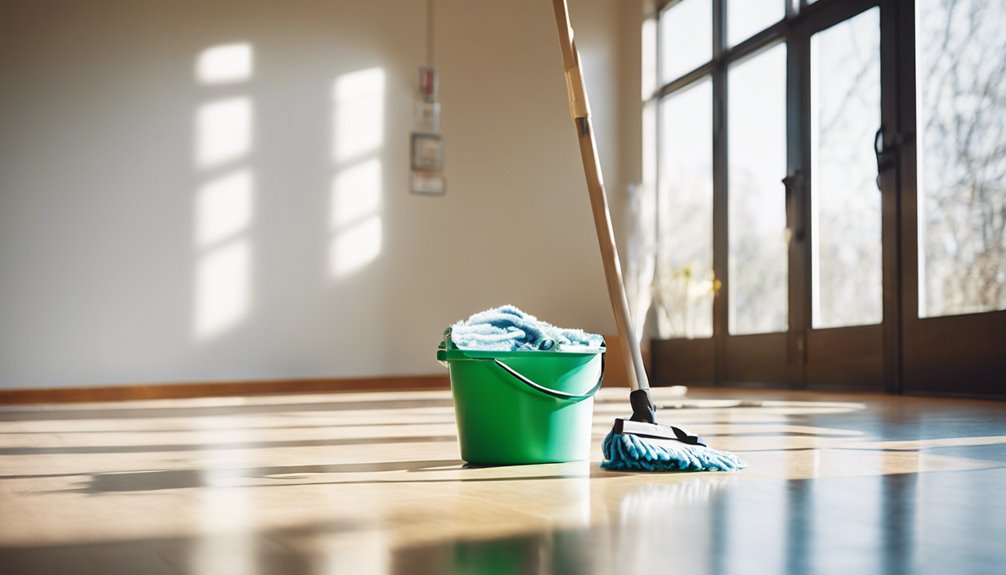
While weekly mopping is a great way to keep your floors clean, incorporating monthly mopping practices can further enhance your home's cleanliness. Establishing a monthly mopping schedule allows you to address areas that may need deeper cleaning, offering significant monthly mopping benefits. Utilize this time to focus on high-traffic zones and corners that often get neglected.
Consider these key points:
- Use a specialized cleaner: Choose products that cater to your floor type for best results.
- Inspect your floors: Look for any damage or wear during your monthly routine.
- Consider a second mop: A dedicated mop for heavy-duty cleaning can save wear on your everyday mop.
Spot Cleaning vs. Mopping
Spot cleaning is often necessary to maintain the appearance and hygiene of your floors between mopping sessions. You should use effective spot cleaning techniques like blotting spills immediately with a clean cloth or using a mild cleaner for stubborn stains. This helps prevent dirt from settling in and keeps your space looking fresh.
While spot cleaning addresses immediate issues, mopping methods serve to deep clean and sanitize your floors. You can choose wet mopping with a traditional mop and bucket or use a microfiber mop for a more efficient approach. Remember, regular mopping complements your spot cleaning efforts, ensuring a healthier environment. Balancing both methods will give you the freedom to enjoy your space without worrying about unsightly messes.
## High-Traffic Areas
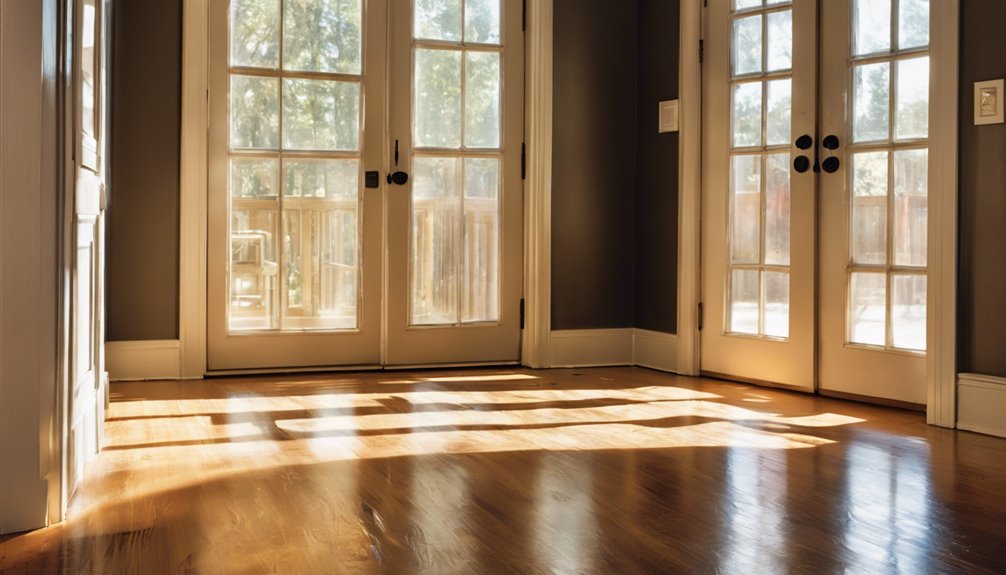
High-traffic areas in your home, such as hallways, entryways, and kitchens, require more frequent mopping than less frequented spaces. To maintain cleanliness in these high traffic zones, consider adjusting your cleaning schedules to include mopping at least once a week, or even more often if you have pets or children. This guarantees that dirt, mud, and spills don't accumulate and become tougher to clean later.
Here are some tips to help you stay on track:
- Keep a mop and cleaning solution easily accessible.
- Set reminders on your calendar to maintain regular mopping.
- Use a microfiber mop for better dirt pickup.
Seasonal Cleaning Tips
As the seasons change, it's crucial to adapt your cleaning routine to guarantee your floors remain in top condition throughout the year. During spring cleaning, focus on deep cleaning your floors, removing built-up dirt and grime that's accumulated over the winter months. This is a great time to use a suitable cleaner that matches your flooring type, ensuring you achieve that fresh, clean look.
In the fall, emphasize maintenance; sweep and mop regularly to combat leaves and dirt tracked inside. You may also want to apply a protective sealant if your floors require it, extending their life. By aligning your cleaning habits with the seasons, you'll enjoy beautiful, well-maintained floors year-round, without the hassle of last-minute deep cleans.
Tools and Techniques for Mopping
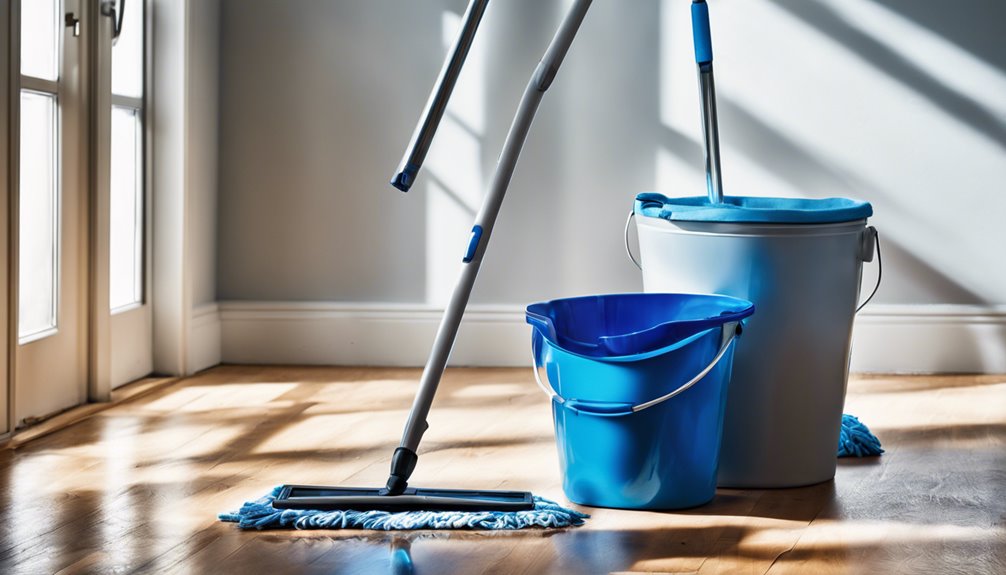
Maintaining a consistent cleaning routine is only part of the equation; the right tools and techniques can make all the difference in how effectively you mop your floors. Start by choosing the appropriate mop types—whether it's a traditional string mop, a microfiber mop, or a steam mop—each serves different purposes. Pair your mop with the right cleaning solutions tailored to your floor type to enhance cleaning power.
- Always wring out excess water to prevent damage.
- Use a figure-eight motion for thorough coverage.
- Change water regularly to avoid spreading dirt.
With the right combination, you'll achieve a sparkling clean floor and enjoy the freedom that comes with a well-maintained living space.
Domande frequenti
Can I Use Vinegar for Mopping All Floor Types?
Yes, you can use vinegar for mopping many floor types, but there are some exceptions. Vinegar's benefits include its natural disinfectant properties and ability to cut through grime. For hardwood or laminate, it's best to dilute vinegar with water, as too much acidity can damage the finish. However, it works well on tile and vinyl. Always test a small area first to verify it won't harm your floor's surface before mopping.
How Do I Know if My Floor Needs Mopping?
To determine if your floor needs mopping, check for visible dirt or stains, and consider the level of foot traffic in the area. If your floor looks dull or sticky, it's likely time to clean. Regularly assess its cleanliness; mopping frequency should match your lifestyle and the grime buildup. Trust your instincts—if it feels dirty or looks less than sparkling, don't hesitate to grab that mop and restore its shine!
What Time of Day Is Best for Mopping?
When you're deciding the best time of day for mopping, consider your morning routine or evening cleanup. Mopping in the morning allows for a fresh start, guaranteeing floors dry before daily activities. However, evening cleanup can be effective if you're tidying up after the day's mess. Whichever you choose, just make certain the floor has enough time to dry and that you're not in a hurry, allowing for a thorough clean.
Should I Rinse My Mop After Each Use?
You might think rinsing your mop after each use is unnecessary, but it's essential for effective mop cleaning and proper mop maintenance. Rinsing removes dirt and cleaning solution residue, preventing it from spreading back onto your floors next time you mop. This simple step can extend your mop's life and enhance your cleaning routine, giving you the freedom to maintain a spotless home without extra effort in the long run.
Is It Safe to Mop With a Steam Cleaner?
Yes, it's safe to mop with a steam cleaner, and there are several benefits to using one. Steam cleaning effectively sanitizes without harsh chemicals, leaving your floors fresh. However, you should take some precautions. Confirm your flooring material is compatible with steam cleaning, as excessive heat can damage certain surfaces. You'll want to avoid steam on unsealed wood or laminate. By following these guidelines, you can enjoy the freedom of a clean, safe home.

